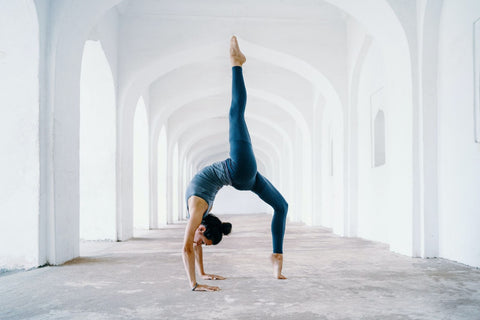
In yoga, the ancient Sanskrit greeting Namaste is “an acknowledgment of the soul in one by the soul in another.” The significance of the greeting elevates when pregnancy merges two souls in one body.
Yoga’s principle tenants are rooted in spirituality; yoga translates to “spiritual discipline” in the religions of Hinduism, Jainism and Buddhism. Through mindful and rhythmic breathing, the mind focuses on the individual breath creating a mental distraction during the contortions of the body. The energy of the body and the soul permeates the mind through each posture creating calmness and enriching physical well being.
Prenatal yoga—or the practice of yoga while pregnant—allows women to remain active when other forms of exercise might become too cumbersome for a blooming baby belly. Yoga also provides a conduit for the mother to spiritually bond with her unborn child.

Yoga Helps A Mother’s Changing Body
When the mind submits to the body through yoga, physical barriers break down. This physical elevation also allows the mother’s body to become unified with the life that she is growing and enables her to further embrace her changing body.
For many women, the bodily changes associated with pregnancy can be a tough transition. An ever-expanding belly transforms physical appearance, and surges of hormones can play havoc with emotions. Yoga helps a woman embrace her body and appreciate its ever-present strength. Georg Feuerstein, an Indologist and yoga scholar said: “So long as we are in conflict with our body, we cannot find peace of mind.”
Yoga helps pregnant women embrace their new bodies and to love and appreciate the growing curves. Despite a growing baby bump, stretch marks and puffiness from water retention, yoga enables women to understand that their bodies are vessels of remarkable strength and miraculous wonder.

Yoga Solves Pregnancy Problems
While the spiritual aspects of yoga help bond and unite two souls in one body, yoga also offers practical solutions for pregnancy. The breath—which is vital to yoga—also is necessary in Lamaze and helps laboring mothers overcome the stress and physical discomfort of contractions.
The Prenatal Yoga Center’s blog entry Breathing for Labor, a Yogic Point of View discusses how breathing patterns learned in yoga also aid the mother during childbirth. According to writer and doula Deb: “One reason prenatal vinyasa yoga is so conducive to teaching expectant moms how to connect to the breath is because it encourages them to link breath and movement. This helps to create a mindful connection to the breath; even if they are in a stationary position, they will have a memory of their own relationship to their breath. When the mother is dealing with the growing pain of a contraction, she has the imprinted memory of connecting to her breath and trying to relax her mind and body.”

Is Yoga During Pregnancy Always Safe?
In addition to aiding the mother during the stressful and painful process of childbirth, yoga also increases flexibility, helps strengthen the body and quiets the mind. While yoga is a safe workout for pregnant mothers, the American Congress of Obstetricians and Gynecologists (ACOG) does advise that during pregnancy women “should avoid poses that require you to be still or lie on your back for long periods….” ACOG’s Committee Opinion on Physical Activity and Exercise During Pregnancy and the Postpartum Period also recommends against particular yoga postures and states that “motionless postures, such as certain yoga positions and the supine position, may result in decreased venous return and hypotension in 10–20% of all pregnant women and should be avoided as much as possible.”
In a 2015 study titled “Yoga in Pregnancy An Examination of Maternal and Fetal Responses to 26 Yoga Poses,” researchers found that “yoga was well tolerated with no acute changes in maternal and fetal well-being.”
However, the study did not include pregnant women who had health risks during their pregnancies such as preeclampsia or gestational diabetes. Women who have been diagnosed with health concerns or who are pregnant with multiples should discuss any yoga practice with their physicians or specialists.

Finding a Yoga Class
Women interested in adding yoga into their daily routine in preparation for childbirth should research specialized prenatal yoga classes led by a certified yoga practitioner. These classes also allow women to meet others who are on the same spiritual and mind/body journey.
Classes specialized for pregnancy also offer support during yoga practice. Balance is often compromised during pregnancy, as the center of gravity shifts in the body. Using chairs or other support items during certain yoga positions also increases safety during yoga, and such support items also were used during the 2015 study that examined the maternal / fetal responses to yoga poses.
When heading to the yoga studio, be sure to wear comfortable yoga clothes that breathe. A pregnant body is naturally warmer, so always dress for comfort and avoid becoming overheated. Always bring plenty of water to stay hydrated. Yoga should be practiced in bare feet to ensure good foot grip on the mat; avoid wearing socks which could slip and cause injury.
Practicing yoga at home is an option for a solo practitioner, but for women whose bodies are growing a new life, self-instructed yoga could lead to common yoga injuries and should be avoided. Do not try to learn yoga from a video at home when practicing during pregnancy. Research instructors and studios to find the right fit for individual needs.
Bikram Yoga, which is practiced in a 105-degree heated studio, also is ill-advised for pregnant women. Elevating the body temperature can be detrimental to both the mother and the baby. Some studies have suggested that an elevated maternal temperature may raise the risk for neural-tube defects, especially when exposure occurs in the first trimester.
Mothers also should listen to their own instincts and bodies while practicing any exercise during pregnancy. Any cramping, pains or other little whispers should not be ignored. If something doesn’t feel right, do not continue and consult your doctor.
As yoga’s popularity has continued to soar in the U. S., so too has the popularity of yoga practice during pregnancy. The breathing techniques used in yoga aids in childbirth, helping to ease the burden of pain from the body and helps increase flexibility. While yoga is safe during pregnancy, certain poses should be avoided—especially postures that require the mother to lie still or on her back for long periods. Women whose pregnancies are complicated by health concerns should always consult a doctor before engaging in yoga.
While the benefits of prenatal yoga are vast, the biggest reward remains the spiritual connection that ties together two bodies and two unique souls. Namaste.






